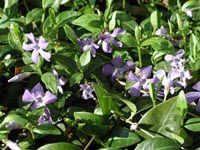Resource Library
Plant of the Week: Periwinkle (Bowles Vinca Minor)
The University of Arkansas System Division of Agriculture does not promote, support or recommend plants featured in "Plant of the Week." Please consult your local Extension office for plants suitable for your region.
Plant of the Week
Bowles Vinca Minor, Periwinkle
Latin: Vinca minor

Gardeners generally resist using Latin names, preferring instead the easier to pronounce and remember colloquial names attached to their favorite plants. But occasionally, a Latin name will cross over that divide and become the common name for a plant.
Two examples of this cross over come to mind. Aloe vera, the medicine plant, is both a Latin name and a common name as is Vinca minor, the common periwinkle. Both names are simple, easy to pronounce and seem to have become firmly established as a part of our vernacular lexicon.
Vinca minor, also called Periwinkle but not to be confused with the annual flower that goes by the same name, is a member of the dogbane family and is one of the most widely used evergreen groundcovers for shaded gardens. Vinca minor is a mat-forming plant with trailing stems that can reach 2 feet long before rooting down. It seldom exceeds 6 inches in height and stays put on the ground, lacking any ability to climb. The 1 ½ inch long, opposite leaves are a dark, glossy blue-green. In March, lilac-blue, tubular five-petaled flowers appear.
Periwinkle is native to Europe and Asia Minor and has been cultivated since ancient times. In some parts of the country, it has escaped cultivation with one Michigan nurseryman calling it the "kudzu of the north." In Arkansas, it seems better behaved and, while untended plantings are often encountered, they are always associated with old home sites or other such manmade plantings.
Over a dozen Vinca minor selections are available from nurserymen, primarily based on flower color or variegation. But, of all the selections, the best in my view is ‘Bowles Variety,’ a typical looking periwinkle, but on steroids. Leaves are slightly larger, flowers are larger and more heavily produced and plants are more vigorous.
This selection was discovered by its namesake, E. A. Bowles (1865 - 1954), in the 1920's growing in a cemetery in France. For 60 years Bowles devoted all of his time, energy and considerable resources to developing a fine garden at Myddelton House on the northern edge of London. Bowles was a hands-on gardener who caused his valet grief by digging into any garden task in his finest clothes. He was a keen plantsman with an eye for unique, and useful plants and has several named in his honor.
What makes Bowles Vinca Minor vigorous is that it appears to be a naturally occurring hybrid with Vinca major, the other periwinkle we sometimes grow in our gardens.
Vinca minor grows best in the humus-rich soils of the deciduous woodlands and grows well in areas receiving very little sunlight during the summer. It’s not well suited for sunny locations where grass will grow, because in a head to head struggle with grass, Vinca always loses. While some claim it grows fine in poor soils, that seems like wishful thinking to me. It is especially well suited to sloping areas where the trailing stems can arch downward.
But Vinca minor is not without its problems. The most serious difficulty is a canker disease of the stem called Phomopsis blight. It produces dead lesions on the stems that cause the shoot beyond the lesion to turn into dead patches throughout the planting. The disease is more severe in wet, poorly drained areas or when grown in too much sun.
By: Gerald Klingaman, retired
Extension Horticulturist - Ornamentals
Extension News - February 28, 2003
The University of Arkansas System Division of Agriculture does not maintain lists of retail outlets where these plants can be purchased. Please check your local nursery or other retail outlets to ask about the availability of these plants for your growing area.